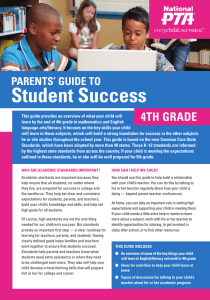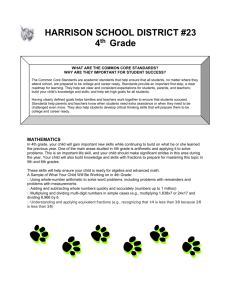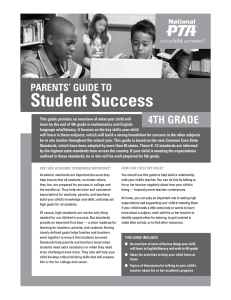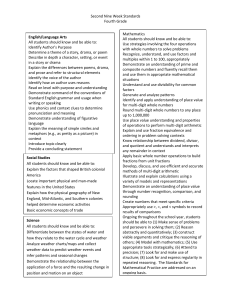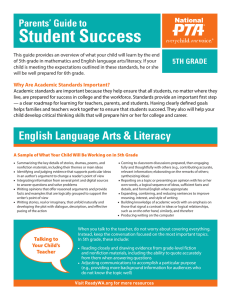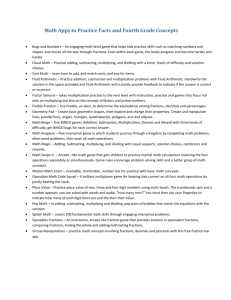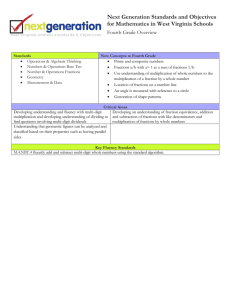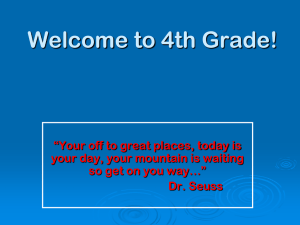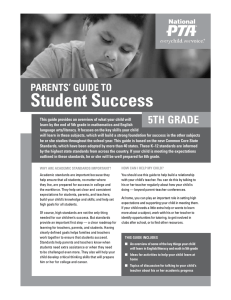Student Success Parents’ Guide to
advertisement
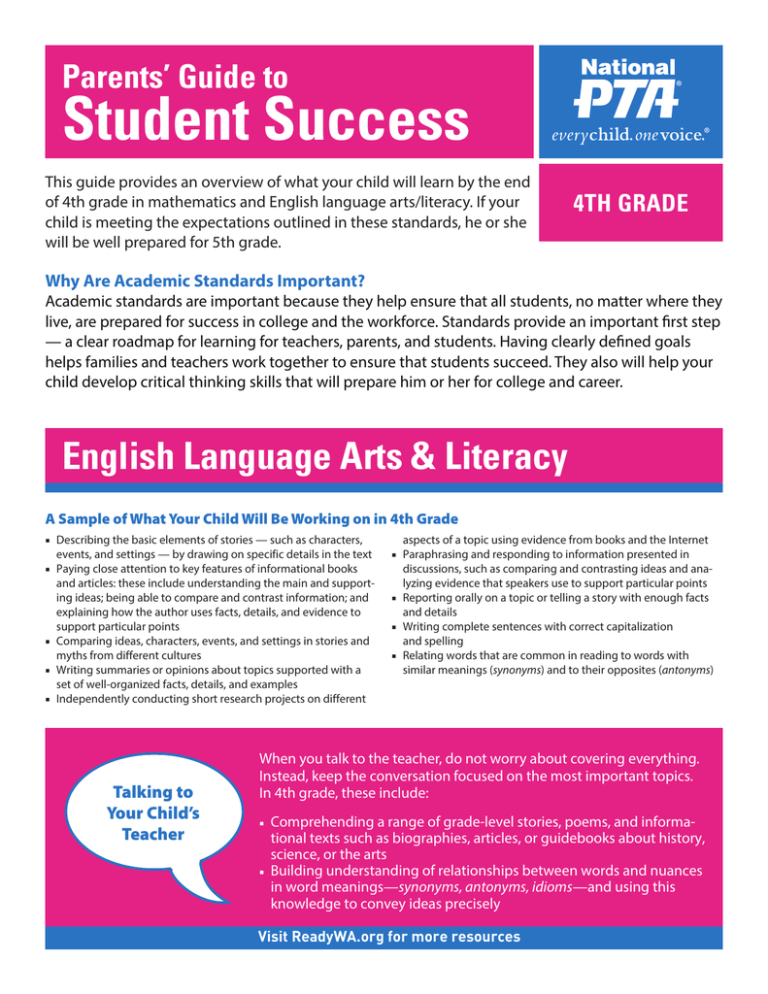
Parents’ Guide to Student Success This guide provides an overview of what your child will learn by the end of 4th grade in mathematics and English language arts/literacy. If your child is meeting the expectations outlined in these standards, he or she will be well prepared for 5th grade. 4th grade Why Are Academic Standards Important? Academic standards are important because they help ensure that all students, no matter where they live, are prepared for success in college and the workforce. Standards provide an important first step — a clear roadmap for learning for teachers, parents, and students. Having clearly defined goals helps families and teachers work together to ensure that students succeed. They also will help your child develop critical thinking skills that will prepare him or her for college and career. English Language Arts & Literacy A Sample of What Your Child Will Be Working on in 4th Grade ■ Describing the basic elements of stories — such as characters, events, and settings — by drawing on specific details in the text ■ Paying close attention to key features of informational books and articles: these include understanding the main and supporting ideas; being able to compare and contrast information; and explaining how the author uses facts, details, and evidence to support particular points ■ Comparing ideas, characters, events, and settings in stories and myths from different cultures ■ Writing summaries or opinions about topics supported with a set of well-organized facts, details, and examples ■ Independently conducting short research projects on different Talking to Your Child’s Teacher aspects of a topic using evidence from books and the Internet ■ Paraphrasing and responding to information presented in discussions, such as comparing and contrasting ideas and analyzing evidence that speakers use to support particular points ■ Reporting orally on a topic or telling a story with enough facts and details ■ Writing complete sentences with correct capitalization and spelling ■ Relating words that are common in reading to words with similar meanings (synonyms) and to their opposites (antonyms) When you talk to the teacher, do not worry about covering everything. Instead, keep the conversation focused on the most important topics. In 4th grade, these include: Comprehending a range of grade-level stories, poems, and informational texts such as biographies, articles, or guidebooks about history, science, or the arts ■ Building understanding of relationships between words and nuances in word meanings—synonyms, antonyms, idioms—and using this knowledge to convey ideas precisely ■ Visit ReadyWA.org for more resources Mathematics A Sample of What Your Child Will Be Working on in 4th Grade ■ Using whole-number arithmetic to solve word problems, including problems with remainders and problems with measurements ■ Adding and subtracting whole numbers quickly and accurately (numbers up to 1 million) ■ Multiplying and dividing multi-digit numbers in simple cases (e.g., multiplying 1,638 × 7 or 24 × 17, and dividing 6,966 by 6) ■ Understanding and applying equivalent fractions (e.g., recognizing that 1⁄4 is less than 3⁄8 because 2⁄8 is less than 3⁄8) ■ Adding, subtracting, and multiplying fractions in simple cases (such as 2 3⁄4 − 1 1⁄4 or 3 × 5⁄8), and solving related word problems ■ Understanding simple decimals in terms of fractions (e.g., rewriting 0.62 as 62⁄100) ■ Measuring angles and finding unknown angles in a diagram When you talk to the teacher, do not worry about covering everything. Instead, keep the conversation focused on the most important topics. In 4th grade, these include: Talking to Your Child’s Teacher ■ Doing arithmetic and solving word problems with multi-digit numbers ■ Doing arithmetic and solving word problems with fractions Help Your Child Learn at Home Try to create a quiet place for your child to study, and carve out time every day when your child can concentrate. You should also try to sit down with your child at least once a week for 15 to 30 minutes while he or she works on homework. This will keep you informed about what your child is working on, and it will help you be the first to know if your child needs help with specific topics. Additionally, here are some activities you can do with your child to support learning at home: English Language Arts & Literacy Mathematics ■ Urge your child to use logical arguments to defend his or her opinion. If your child wants a raise in allowance, ask him or her to research commonsense allowance systems and, based on that research, explain reasons why, supported by facts and details. ■ Talk about the news together. Pick one story in the news, read it together, and discuss with your child what it means. ■ Ask your child to compare numbers using phrases like “times as much.” For example, if the family cat weighs 8 lbs. and the family dog weighs 56 lbs., how many times as much does the dog weigh? ■ Ask your child to help you compare fractional amounts — for example, if one recipe calls for 2⁄3 of a cup of oil, but another recipe calls for 3⁄4 of a cup of oil, which recipe calls for more oil? (In 5th grade, your child will learn ways to determine just how much more oil.) For more information, the full standards are available at www.corestandards.org. National Office: 1250 N Pitt Street • Alexandria, VA 22314 • Toll-Free: (800) 307-4PTA (4782) • PTA.org • info@pta.org © 2012 PTA All rights reserved. Printed in U.S.A. (9/12) • and everychild.onevoice.® are registered service marks of the National Congress of Parents and Teachers. Visit ReadyWA.org for more resources
